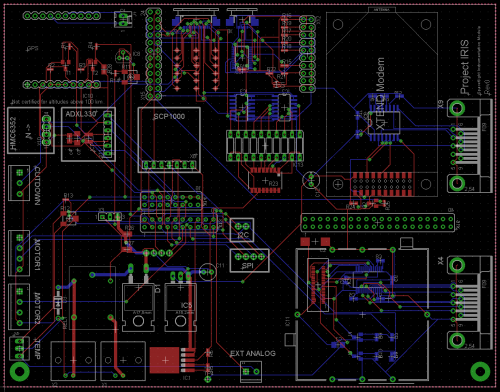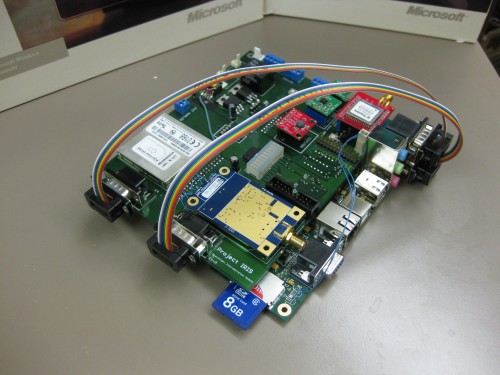We’ve been insanely busy over the last couple of weeks getting everything together, so we haven’t really had much of a chance to update the website and let you guys know what our electronics design is all about.
Our electronics package (which we call the FCU, or “flight control unit”) consists of two circuit boards. First is the Orchid/Colibiri carrier board, which we purchased from Toradex and contains the main CPU, memory, Ethernet controller, USB, and other “standard” peripherals. Naturally, this board doesn’t come equipped with the “nonstandard” instrumentation needed by Project IRIS: the 900MHz long-range UHF modem, GPS, GSM cellular module, accelerometers, magnetic compass module, barometric pressure sensor and so forth. We had to design our own daughterboard, which would sit on top of the carrier board to make an electronics “sandwich” of sorts.
A few weeks back, we created the circuit schematics using the EAGLE layout software, which contains thousands of libraries for standard components and also the physical “footprint” of each electronic part to assist us in designing the actual printed circuit board (PCB). After a few weeks of design, our fully laid-out PCB looked something like this (you get a prize if you can spot the errors!):

This is a two-layer PCB with a minimum trace width of 7 mils (0.007″), which is the smallest feature that can be produced by our circuit board manufacturer, AP Circuits. We can’t recommend these guys enough – we got our board back in 2 business days, complete with solder mask, legend layers, HASL (hot-air solder leveling – a special process to pre-coat all the exposed pads with solder), and not a single manufacturing defect that we could find. After another week of soldering and re-work to fix our design errors (if you look closely, you can see some small wires on on the board to take care of some mistakes we made in the initial prototype design), we selectively powered up each component and made sure everything worked. Click on the below image to see a 3D Photosynth of the complete FCU assembly with the two circuit boards mated together:
You might be wondering about the ribbon cables going across the top of the board; we’re using a few serial devices (the GSM, GPS and UHF modules), and to make development/debugging easier, we decided to keep the DB9 serial connectors so we could plug a computer into our board and interface with those components directly from a PC.
We’re now starting to think about our second revision of the board, which will be in design shortly to get rid of the design errors in the initial prototype.

